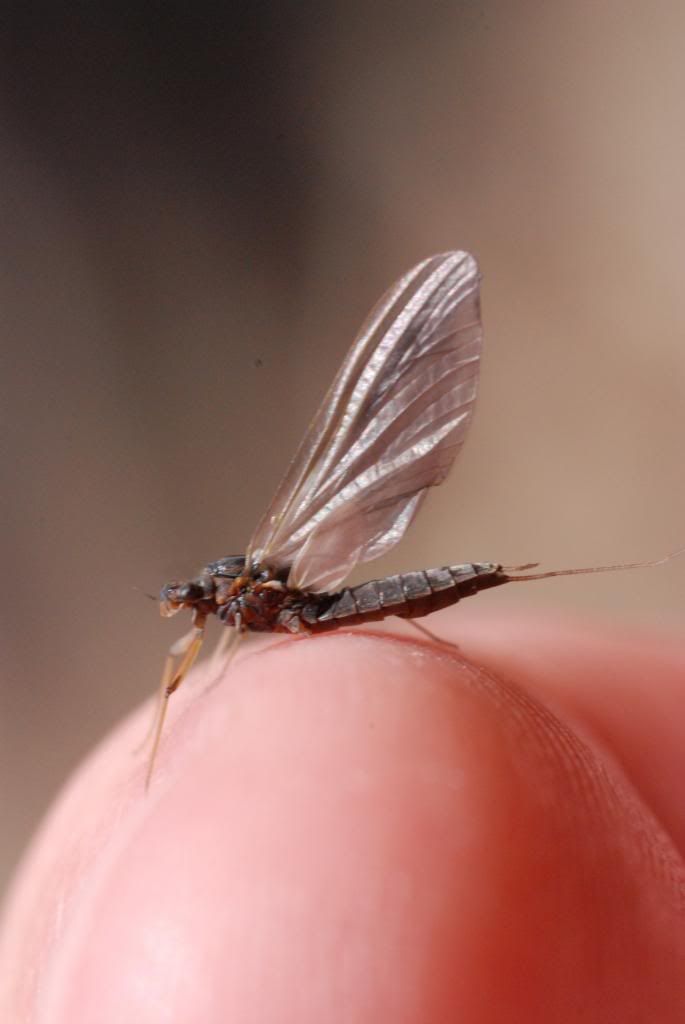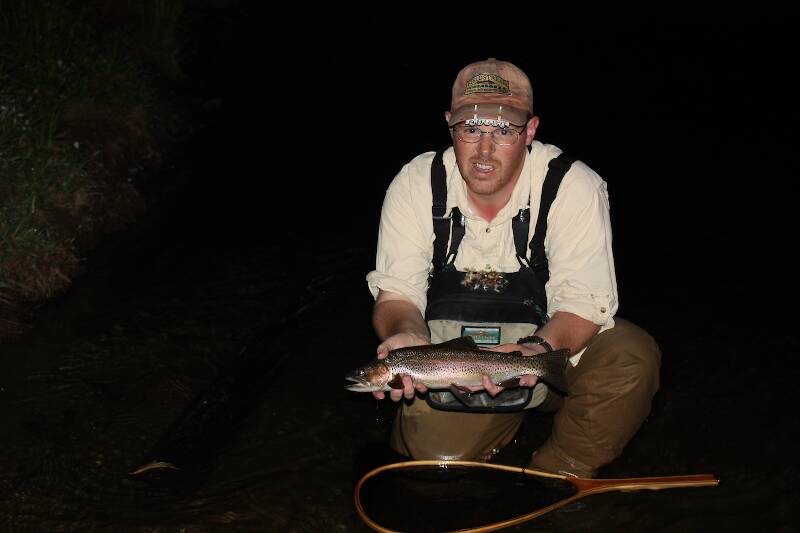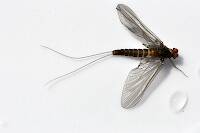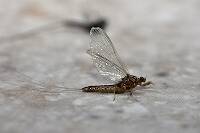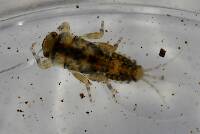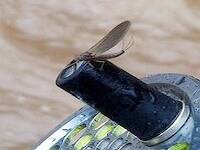
Hex Mayflies
Hexagenia limbata
The famous nocturnal Hex hatch of the Midwest (and a few other lucky locations) stirs to the surface mythically large brown trout that only touch streamers for the rest of the year.
Featured on the forum

This one pretty clearly keys to Kogotus, but it also looks fairly different from specimens I caught in the same creek about a month later in the year. With only one species of the genus known in Washington, I'm not sure about the answer to this ID.

Troutnut is a project started in 2003 by salmonid ecologist Jason "Troutnut" Neuswanger to help anglers and
fly tyers unabashedly embrace the entomological side of the sport. Learn more about Troutnut or
support the project for an enhanced experience here.
Martinlf on Mar 18, 2014March 18th, 2014, 7:40 pm EDT
Tiny ??
"He spread them a yard and a half. 'And every one that got away is this big.'"
--Fred Chappell
--Fred Chappell
Taxon on Mar 18, 2014March 18th, 2014, 9:33 pm EDT
Eric-
Perhaps Paraleptophlebia debilis or Paraleptophlebia praepedita, both of which I believe to have October emergences.
Perhaps Paraleptophlebia debilis or Paraleptophlebia praepedita, both of which I believe to have October emergences.
Entoman on Mar 19, 2014March 19th, 2014, 5:33 pm EDT
Seems a little stocky to me for a Mahogany dun. Were the tails subequal or was the terminal filament shorter and thinner?
"It's not that I find fishing so important, it's just that I find all other endeavors of Man equally unimportant... And not nearly as much fun!" Robert Traver, Anatomy of a Fisherman
JOHNW on Mar 19, 2014March 19th, 2014, 6:12 pm EDT
I am beating Spence to the punch on this one! Looks like a Lil brown bastard if you want my opinion.
"old habits are hard to kill once you have gray in your beard" -Old Red Barn
Entoman on Mar 20, 2014March 20th, 2014, 5:23 am EDT
Yes, but for a variety of characters including the shape of the hind wings and a lack of detached intercalaries, that family is out of the money.
"It's not that I find fishing so important, it's just that I find all other endeavors of Man equally unimportant... And not nearly as much fun!" Robert Traver, Anatomy of a Fisherman
Crepuscular on Mar 20, 2014March 20th, 2014, 5:32 am EDT
It does look a little chunky I originally though maybe a Ephemerella because of that, but I don't think it is. Do any Ephemerella hatch that late in the session ???
Definitely Leptophlebidae. I thought it was a little portly to be a Paralep. But am totally unsure. So Rodger may be correct. The caudal filaments were broken Kurt, so I can't answer your question. Choroterpes perhaps if not Paralep? I've never seen one
Martinlf on Mar 20, 2014March 20th, 2014, 6:56 am EDT
Eric what was the length? It appears to be on a finger or ridge of the hand, and very small. Perhaps it's an undercover Trico trying to get some information about the Leptophlebidae drug cartel.
"He spread them a yard and a half. 'And every one that got away is this big.'"
--Fred Chappell
--Fred Chappell
Crepuscular on Mar 20, 2014March 20th, 2014, 7:00 am EDT
Eric what was the length? It appears to be on a finger or ridge of the hand, and very small. Perhaps it's an undercover Trico trying to get some information about the Leptophlebidae drug cartel.
Above the photo I have the length listed. Are you not seeing that? it was 7-8 mm
Taxon on Mar 20, 2014March 20th, 2014, 8:54 am EDT
Crepuscular on Mar 20, 2014March 20th, 2014, 12:29 pm EDT
Ahh cool. Like I said I've never seen one. Thanks for the info.
Oldredbarn on Mar 20, 2014March 20th, 2014, 3:36 pm EDT
I'm going to add my lowly two-cents here and vote for the Paralep...JohnW's comments aside. :)
These things sometimes remain a mystery and bad science is after-all bad science, so don't place too much on my guess here, I'm just dropping a buck to play in the lottery...
Paraleptophlebia debilis (Walker). From Justin Leonard: "Subimago: 7-9mm. Body dark brown, with olive sheen; wings slate-blue; legs and tails light olive; middle section of abdomen paler than base and apex."
"Emergence: July 5-October 27."
"This species is a member of the autumnal fauna, emerging in greatest numbers during September. Mating flights are common on sunny afternoons long after nightly frosts have become the rule."
Mack, I think, mentioned Hatches which has a couple pics that are supposed to be P adoptiva where the female was "chunkier" than the male, and had longish fore legs...Do we think that this could be a female?
"lack of detached intercalaries" Kurt. I haven't been able to enlarge this pic, but you can see this in this photo?
So...There we are..."Stuck in the middle again..." JohnW. What you say my friend, a Borchers Parachute, say 16-18? :) Maybe one of your Quill Gordons...
Spence
These things sometimes remain a mystery and bad science is after-all bad science, so don't place too much on my guess here, I'm just dropping a buck to play in the lottery...
Paraleptophlebia debilis (Walker). From Justin Leonard: "Subimago: 7-9mm. Body dark brown, with olive sheen; wings slate-blue; legs and tails light olive; middle section of abdomen paler than base and apex."
"Emergence: July 5-October 27."
"This species is a member of the autumnal fauna, emerging in greatest numbers during September. Mating flights are common on sunny afternoons long after nightly frosts have become the rule."
Mack, I think, mentioned Hatches which has a couple pics that are supposed to be P adoptiva where the female was "chunkier" than the male, and had longish fore legs...Do we think that this could be a female?
"lack of detached intercalaries" Kurt. I haven't been able to enlarge this pic, but you can see this in this photo?
So...There we are..."Stuck in the middle again..." JohnW. What you say my friend, a Borchers Parachute, say 16-18? :) Maybe one of your Quill Gordons...
Spence
"Even when my best efforts fail it's a satisfying challenge, and that, after all, is the essence of fly fishing." -Chauncy Lively
"Envy not the man who lives beside the river, but the man the river flows through." Joseph T Heywood
"Envy not the man who lives beside the river, but the man the river flows through." Joseph T Heywood
JOHNW on Mar 20, 2014March 20th, 2014, 4:10 pm EDT
" Maybe one of your Quill Gordons..."
Sorry Spence I only tie Gordon's Quill.
However a stripped peacock Blue quill would do nicely.
Sorry Spence I only tie Gordon's Quill.
However a stripped peacock Blue quill would do nicely.
"old habits are hard to kill once you have gray in your beard" -Old Red Barn
Taxon on Mar 20, 2014March 20th, 2014, 4:32 pm EDT
Spence,
Certainly would not presume to speak for "we", but I believe it to be a female subimago. In my experience with winged mayflies, it is not unusual for the female of a given species to have a somewhat more robust abdomen, and have a slightly longer body length that the male.
Do we think that this could be a female?
Certainly would not presume to speak for "we", but I believe it to be a female subimago. In my experience with winged mayflies, it is not unusual for the female of a given species to have a somewhat more robust abdomen, and have a slightly longer body length that the male.
Entoman on Mar 20, 2014March 20th, 2014, 6:41 pm EDT
Spence - Yes, the lack of intercalaries is quite noticeable when the photo is enlarged a little.
Eric - As for genus and species, I agree with Roger about Choroterpes and don't necessarily disagree with his other ideas.
For the sake of further discussion though, I found the following quote from Edmunds etal in MONACA regarding Leptophlebia johnsoni (Little Black Quill, Jenny Spinner) quite interesting:
Another nugget - determining between the two based on brood emergence date or leg/body color has also been found to be unreliable.
Hmm...
Eric - As for genus and species, I agree with Roger about Choroterpes and don't necessarily disagree with his other ideas.
For the sake of further discussion though, I found the following quote from Edmunds etal in MONACA regarding Leptophlebia johnsoni (Little Black Quill, Jenny Spinner) quite interesting:
The separation of the genera Leptophlebia and Paraleptophlebia is simple with one exception... Leptophlebia johnsoni is the smallest North American Leptophlebia (7mm) and its wings do not appear to differ in any character from that of Paraleptophlebia. Within its geographic range, most Paraleptophlebia can be smaller and their caudal filaments are usually uniformly pale rather than tan with reddish brown rings at the joinings as found in L. johnsoni.
Another nugget - determining between the two based on brood emergence date or leg/body color has also been found to be unreliable.
Hmm...
"It's not that I find fishing so important, it's just that I find all other endeavors of Man equally unimportant... And not nearly as much fun!" Robert Traver, Anatomy of a Fisherman
Martinlf on Mar 21, 2014March 21st, 2014, 8:58 am EDT
Above the photo I have the length listed. Are you not seeing that? it was 7-8 mm
Eric, I think the way my browser pulled up the post the text above the photo didn't pop up, or, I just missed it. Wouldn't be the first time.
"He spread them a yard and a half. 'And every one that got away is this big.'"
--Fred Chappell
--Fred Chappell
Entoman on Mar 23, 2014March 23rd, 2014, 11:52 am EDT
Louis - Eric's measurement didn't show up at first on mine either, don't know why.
John - Actually you are closest to the mark of any of us. Little (yep) Brown (undeniably) Bastard (since its parentage is questionable, is there a better word?) Kudos for the most accurate ID of the thread! LOL
John - Actually you are closest to the mark of any of us. Little (yep) Brown (undeniably) Bastard (since its parentage is questionable, is there a better word?) Kudos for the most accurate ID of the thread! LOL
"It's not that I find fishing so important, it's just that I find all other endeavors of Man equally unimportant... And not nearly as much fun!" Robert Traver, Anatomy of a Fisherman
Quick Reply
Related Discussions
Topic
Replies
Last Reply
2
Mar 21, 2007
by CalebBoyle
by CalebBoyle
6
Nov 12, 2006
by Martinlf
by Martinlf



